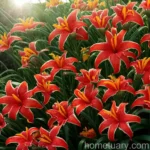Daylily (Hemerocallis ‘Nuthatch’) – A Complete Plant Guide
In the world of gardening, daylilies have always been a popular choice due to their adaptability, low maintenance, and stunning blooms. Among the wide array of daylily varieties, Hemerocallis ‘Nuthatch’ stands out for its unique characteristics and reliable performance in gardens. In this comprehensive plant guide, we will delve into all aspects of caring for Hemerocallis ‘Nuthatch’, covering everything from its cultural requirements to its landscape uses.
What is a Daylily?
The daylily, scientifically known as Hemerocallis, is a perennial flowering plant that belongs to the genus Hemerocallis and the family Asphodelaceae. Despite its common name, it is not a true lily, as true lilies belong to the genus Lilium. The name “daylily” is derived from the plant’s short-lived blooming period, with each flower typically lasting only one day. However, daylily plants produce multiple flower buds on each stem, resulting in a prolonged blooming season.
Hemerocallis ‘Nuthatch’, specifically, is a cultivar known for its distinct characteristics, making it a sought-after choice for gardeners and landscapers. Understanding its specific requirements and features is crucial for successfully integrating it into a garden or landscape design.
Hemerocallis ‘Nuthatch’ – Key Takeaways
Culture
- Hardiness Zone: Hemerocallis ‘Nuthatch’ thrives in USDA hardiness zones 3-9, making it adaptable to a wide range of climates.
- Growth Habit: This variety exhibits a clumping growth habit, with its mounds of foliage and tall flower scapes adding vertical interest to garden landscapes.
- Bloom Time: Hemerocallis ‘Nuthatch’ typically blooms in midsummer, adding vibrant color to the garden when many other plants are not in flower.
Uses
- Landscape Uses: Ideal for borders, mass plantings, and mixed perennial gardens, Hemerocallis ‘Nuthatch’ enhances the visual appeal of various landscape settings.
- Container Planting: It can also be grown successfully in containers, allowing for versatile garden design options.
Water
- Water Needs: Hemerocallis ‘Nuthatch’ has moderate water needs and should be watered regularly, especially during periods of drought.
- Disease Prevention: Avoid overhead watering to prevent fungal diseases, as moist foliage can promote the development of pathogens.
Sunlight
- Sun Requirements: It prefers full sun to partial shade, thriving in areas with at least 6 hours of direct sunlight per day.
- Winter Protection: In regions with harsh winters, providing adequate winter protection is necessary to ensure the plant’s survival and vigor.
Fertilizer
- Soil Fertilization: Regular feeding with a balanced, slow-release fertilizer helps promote healthy foliage and abundant flowering.
- Organic Gardening Methods: Consider using organic fertilizers to maintain soil fertility and support sustainable gardening practices.
Soil
- Soil Preferences: Well-draining, fertile soil is essential for Hemerocallis ‘Nuthatch’, and incorporating organic matter aids in soil structure and moisture retention.
- Container Planting: When grown in containers, a high-quality potting mix with good drainage is crucial for the plant’s overall health.
Pruning
- Pruning Techniques: Deadheading spent flowers and removing old foliage can prolong the blooming period and maintain the plant’s neat appearance.
- Clump Division: Periodic division of large clumps is recommended to rejuvenate the plants and prevent overcrowding.
Propagation
- Propagation: Daylilies can be propagated through division, seeds, or cutting propagation methods, allowing for the expansion of plantings or the creation of new varieties.
Common Diseases
- Disease Diagnosis: Keep an eye out for common daylily diseases such as leaf streak, rust, and crown rot, implementing appropriate measures for prevention and management.
- Companion Flowers: Planting disease-resistant companion flowers can help safeguard daylilies from certain pathogens.
Common Pests
- Pest Control: While daylilies are relatively pest-resistant, occasional pest issues, such as aphids and thrips, may arise and require targeted control measures.
Botanist’s Tips for Hemerocallis ‘Nuthatch’
Fun Facts
- Hemerocallis ‘Nuthatch’ belongs to the family Asphodelaceae, which includes various ornamental species such as Kniphofia and Asphodelus.
- The common name “daylily” reflects the fleeting nature of each flower’s beauty, which is renewed daily throughout the blooming season.
Links to External Resources
Conclusion
As an integral part of many gardens and landscapes, Hemerocallis ‘Nuthatch’ offers an abundance of benefits, from its vibrant blooms to its resilient nature. By understanding the specific needs and characteristics of this cultivar, gardeners can harness its full potential and create stunning displays. Whether grown in borders, containers, or mixed perennial gardens, Hemerocallis ‘Nuthatch’ stands as a testament to the enduring allure of daylilies in horticulture.
Incorporating botanist-recommended practices and leveraging the insights shared in this guide will empower enthusiasts and professionals alike to cultivate thriving specimens of Hemerocallis ‘Nuthatch’ while appreciating its ornamental and ecological value in the garden.
Remember, successful gardening is a continuous learning process, and each experience with Hemerocallis ‘Nuthatch’ offers an opportunity to deepen our understanding of its nuances and refine our horticultural skills.
Happy gardening!















